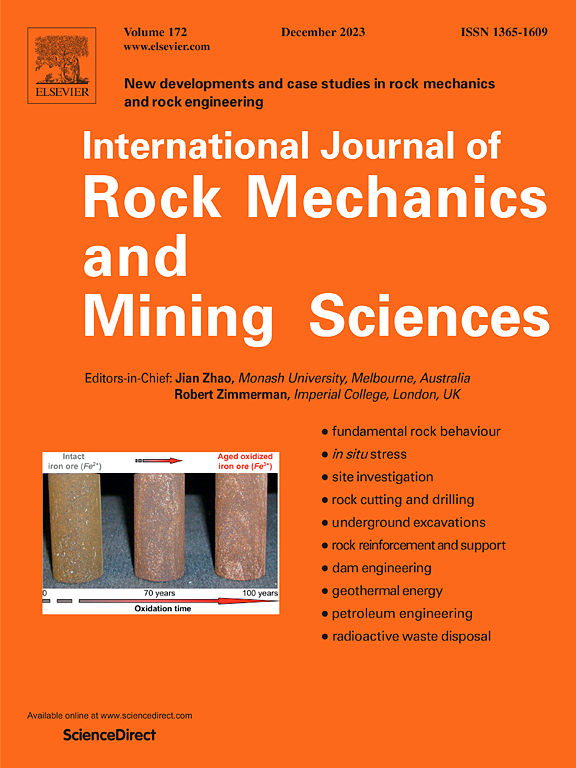Micromechanical model for simulating load transfer behavior and damage evolution for fully grouted rockbolt under axial loads
IF 7
1区 工程技术
Q1 ENGINEERING, GEOLOGICAL
International Journal of Rock Mechanics and Mining Sciences
Pub Date : 2024-11-26
DOI:10.1016/j.ijrmms.2024.105971
引用次数: 0
Abstract
In the present paper the problems of the nonlinear debonding of anchorage interface, the strain-hardening and rupture of rockbolt, and the progressive damage of heterogeneous rock for the fully grouted rockbolt under axial loads are studied. A micromechanical numerical model is developed and implemented into the finite difference programme, to analyze the load transfer mechanism and damage evolution by introducing the bi-exponential shear slip model of interface, bilinear strain-hardening model of rockbolt and elastic damage model of rock. The close agreement between the simulation results of the proposed model and the theoretical and experimental data validates the model's capability for accurately characterizing the pull-out behavior of the grouted rockbolt. Failure type strongly depends on the strength of rock and anchorage interface, as well as the anchorage length. In particular, when rock strength is low, strain energy is predominantly dissipated through rock damage, leading to the interface failing to fully mobilize its load transfer effect, especially at a relatively long anchorage length. Moreover, the excessive interfacial adhesion performance causes a large range of serious damage in rock near the interface and leads to peak pull-out load even lower than the rockbolt with poor interfacial bonding properties. Finally, the critical anchorage length is investigated and the load transfer mechanism of the fully grouted rockbolt is clarified by comparing the case with or without rock damage. It is therefore very useful of the developed micromechanical model, since it provides an essential understanding of the load transferring capacity and failure type of the fully grouted rockbolt, especially under rock damage.
模拟轴向荷载下全灌浆岩螺栓荷载传递行为和损伤演变的微观力学模型
本文研究了全灌浆锚杆在轴向荷载作用下,锚固界面的非线性剥离、锚杆的应变硬化和断裂以及异质岩石的渐进破坏问题。通过引入界面的双指数剪切滑移模型、锚杆的双线性应变硬化模型和岩石的弹性破坏模型,建立了微观力学数值模型,并将其应用于有限差分程序,以分析荷载传递机制和破坏演化过程。提出的模型模拟结果与理论和实验数据非常接近,验证了该模型能够准确描述灌浆锚杆的拉拔行为。破坏类型与岩石和锚固界面的强度以及锚固长度密切相关。特别是当岩石强度较低时,应变能主要通过岩石破坏耗散,导致界面无法充分发挥其荷载传递作用,尤其是在锚固长度相对较长的情况下。此外,过高的界面粘结性能会导致界面附近的岩石出现大范围的严重破坏,并导致峰值拉拔载荷甚至低于界面粘结性能较差的锚杆。最后,研究了临界锚固长度,并通过比较有无岩石破坏的情况,阐明了全灌浆锚杆的荷载传递机制。因此,所开发的微观力学模型非常有用,因为它提供了对全灌浆锚杆荷载传递能力和破坏类型的基本理解,尤其是在岩石破坏的情况下。
本文章由计算机程序翻译,如有差异,请以英文原文为准。
求助全文
约1分钟内获得全文
求助全文
来源期刊
CiteScore
14.00
自引率
5.60%
发文量
196
审稿时长
18 weeks
期刊介绍:
The International Journal of Rock Mechanics and Mining Sciences focuses on original research, new developments, site measurements, and case studies within the fields of rock mechanics and rock engineering. Serving as an international platform, it showcases high-quality papers addressing rock mechanics and the application of its principles and techniques in mining and civil engineering projects situated on or within rock masses. These projects encompass a wide range, including slopes, open-pit mines, quarries, shafts, tunnels, caverns, underground mines, metro systems, dams, hydro-electric stations, geothermal energy, petroleum engineering, and radioactive waste disposal. The journal welcomes submissions on various topics, with particular interest in theoretical advancements, analytical and numerical methods, rock testing, site investigation, and case studies.

 求助内容:
求助内容: 应助结果提醒方式:
应助结果提醒方式:


